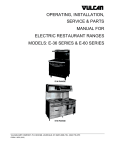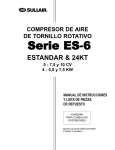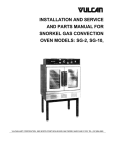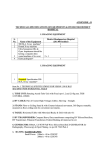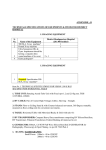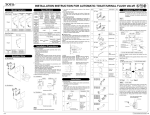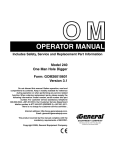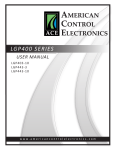Download Vulcan-Hart ET4 Operating instructions
Transcript
INSTALLATION, SERVICE AND PARTS MANUAL FOR ET4 ELECTRIC HALF SIZE CONVECTION OVEN VULCAN-HART COMPANY, P 0. BOX 696, LOUISVILLE, KY 40201 -0696, TEL. (502) 778-2791 IMPORTANT OPERATING, INSTALLATION AND SERVICE PERSONNEL Operating information for this equipment has been prepared for use by qualified and/or authorized operating personnel All installation and service on this equipment is to be performed by qualified, certified, licensed and/or authorized installation or service personnel, with the exception of any marked with a ? in front of the part number Service may be obtained by contacting the Factory Service Department, Factory Representative or Local Service Agency DEFINITIONS QUALIFIED AND/OR AUTHORIZED OPERATING PERSONNEL Qualified or authorized operating personnel are those who have carefully read the information in this manual and are familiar with the equipments functions or have had previous experience with the operation of the equipment covered in this manual QUALIFIED INSTALLATION PERSONNEL Qualified installation personnel are individuals, a firm, corporation or company which either in person or through a representative are engaged in, and are responsible for 1. The installation of gas piping from the outlet side of the gas meter, or the service regulator when the meter is not provided, and the connection and installation of the gas appliance Qualified installation personnel must be experienced in such work, be familiar with all precautions required, and have complied with all requirements of state or local authorities having jurisdiction Reference in the United States of America National Fuel Gas code ANSI Z223 1 (Latest Edition) In Canada-Canadian Standard CAN1-B149 1 NAT GAS (Latest Edition) or CAN1-B149 2 PROPANE (Latest Edition) 2. The installation of electrical wiring from the electric meter, main control box or service outlet to the electric appliance Qualified installation personnel must be experienced in such work, be familiar with all precautions required, and have complied with all requirements of state or local authorities having jurisdiction Reference In the United States of America-National Electrical Code ANSI NFPA No 70 (Latest Edition) In Canada-Canadian Electrical Code Part 1 CSA-C22 1 (Latest Edition) QUALIFIED SERVICE PERSONNEL Qualified service personnel are those who are familiar with Vulcan equipment who have been endorsed by the Vulcan-Hart Corporation All authorized service personnel are required to be equipped with a complete set of service parts manuals and stock a minimum amount of parts for Vulcan equipment SHIPPING DAMAGE CLAIM PROCEDURE For your protection, please note that equipment in this shipment was carefully inspected and packed by skilled personnel before leaving the factory. The transportation company assumes full responsibility for safe delivery upon acceptance of this shipment If shipment arrives damaged: 1. VISIBLE LOSS OR DAMAGE — Be certain this is noted on freight bill or express receipt and signed by person making delivery 2. FILE CLAIM FOR DAMAGES IMMEDIATELY — Regardless of extent of damage 3. CONCEALED LOSS OR DAMAGE — If damage is unnoticed until merchandise is unpacked, notify transportation company or carrier immediately, and file "concealed damage" claim with them This should be done within (15) days of date of delivery is made to you Be sure to retain container for inspection We cannot assume responsibility for damage or loss incurred in transit We will, however, be glad to furnish you with necessary documents to support your claim PLEASE RETAIN THIS MANUAL FOR FUTURE REFERENCE IMPORTANT NOTES FOR ALL VULCAN APPLIANCES 1. These units are produced with the best possible workmanship and material. Proper installation is vital if best performance and appearance are to be achieved. Installer must follow the installation instructions carefully. 2. Information on the construction and installation of ventilating hoods may be obtained from the “Standard for the installation of equipment for the removal of smoke and grease laden vapors from commercial cooking equipment,” NFPA No 96 (latest edition) available from the National Fire Protection Association, Battery March Park Quincy MA 02269. 3. For an appliance equipped with a flexible electric supply cord, the cord is equipped with a three prong (grounding) plug. This grounding plug is for your protection against shock hazard and should be plugged directly into a properly grounded three-prong receptacle. Do not cut or remove the grounding prong from this plug If the appliance is not equipped with a grounding plug, and electric supply is needed, ground the appliance by using the ground lug provided (refer to the wiring diagram). (FOR GAS APPLIANCES ONLY) 4. Do not obstruct the air flow into and around the appliance This air flow is necessary for proper combustion of gases and for ventilation of the appliance Provisions for ventilation of incoming air supply for the equipment in the room must be in accordance with National Fuel Gas Code ANSI Z223 1 (latest edition) 5. Do not obstruct the flow of flue gases from the flue duct (when so equipped) located on the rear (or sides) of the appliance. It is recommended that the flue gases be ventilated to the outside of the building through a ventilation system installed by qualified personnel. 6 For an appliance equipped with casters, (1) the installation shall be made with a connector that complies with the Standard for Connectors for Movable Gas Appliances, ANSI Z21. 69 (latest edition), and Addenda, Z21.69a (latest edition), and a quickdisconnect device that complies with the Standard for Quick-Disconnect Devices for Use With Gas Fuel, ANSI Z21. 41 (latest edition), and Addenda, Z21. 41 a (latest edition) and Z21. 41 b (latest edition) and (2) adequate means must be provided to limit the movement of the appliance without depending on the connector and the quick-disconnect device or its associated piping to limit the appliance movement If disconnection of the restraint is necessary, reconnect this restraint after the appliance has been returned to its originally installed position. 7 The appliance and its individual shutoff valve must be disconnected from the gas supply piping system during any pressure testing of that system at test pressures in excess of 1/2 psig (3.45 k Pa) 8 The appliance must be isolated from the gas suppiy system by closing its individual manual shutoff valve during any pressure testing of the gas supply system at test pressures equal to or less than 1/2 psig (3 45 k Pa) CAUTIONS FOR YOUR SAFETY DO NOT STORE OR USE GASOLINE OR OTHER FLAMMABLE VAPORS AND LIQUIDS IN THE VICINITY OF THIS EQUIPMENT OR ANY OTHER APPLIANCE. 1. KEEP THE APPLIANCE FREE AND CLEAR FROM ALL COMBUSTIBLE SUBSTANCES. 2. IN THE EVENT A GAS ODOR IS DETECTED, SHUT UNIT(S) DOWN AT THE MAIN SHUTOFF VALVE AND CONTACT THE LOCAL GAS COMPANY OR GAS SUPPLIER FOR SERVICE. 3. POST IN A PROMINENT LOCATION, INSTRUCTIONS TO BE FOLLOWED IN THE EVENT THE SMELL OF GAS IS DETECTED. THIS INFORMATION MAY BE OBTAINED FROM A LOCAL GAS SUPPLIER. INSTALLATION, SERVICE & PARTS MANUAL FOR ET-4 ELECTRIC HALF SIZE CONVECTION OVEN All Vulcan equipment is produced with the best possible workmanship. Proper usage and maintenance will result in many years of satisfactory performance. INDEX The manufacturer suggests that this entire manual be thoroughly read and all instructions provided within be carefully followed. DESCRIPTION PAGE DEFINITIONS OF PERSONNEL (Installation, Service & Parts) and SHIPPING DAMAGE CLAIM PROCEDURES (Inside Front Cover) IMPORTANT NOTES 116021-1 INDEX 116021 - 2 CAUTIONS 116021-2 INSTALLATION INSTRUCTIONS 116021-3 GENERAL THEORY OF OPERATION 116021-3 OPERATING INSTRUCTIONS 116021-4 PREHEATING, LOADING, UNLOADING & CLEANING 116021-5 COOKING CHART 116021-5 & 6 OPERATORS TROUBLE SHOOTING 116021-7 SERVICE PERSONNEL TROUBLE SHOOTING PARTS DESCRIPTION AND REPLACEMENT REPLACEMENT PARTS LIST & PHOTOGRAPHS REVISION PAGE 116021-8 & 9 116021 - 9 thru -11 116021 - 12 thru -17 (Inside Back Cover) CAUTIONS AND NOTATIONS NOTE: A complete set of wiring diagrams are packaged in a separate envelope and sent out with the unit. A wiring diagram decal may also be found on the back of the unit next to the electrical supply line. OPENING OVEN DOOR: Opening oven door will automatically cut "off" fan and heating elements. However, hot air gathered within the oven cavity may be thrusted outwards when the door is opened. CAUTION: DO NOT stand directly in front of oven while opening door. When opening door, operator should pull handle outward while simultaneously stepping back away from the front of the unit. Load oven as quickly as possible to conserve heat. Center pans on racks. NOTE: All Vulcan electric convection ovens are equipped with an electrical rating plate indicating unit model number, serial number, unit voltage, motor volts, motor amps, unit phase and heater kilowatts. The rating plate may be found mounted on the cover of the terminal box located to the lower right hand corner of body back when facing unit from the front. 116021-2 INSTALLATION INSTRUCTIONS Vulcan electric convection ovens are U.L. listed under file number E75870 and are manufactured for use on electrical service of the characteristics specified on the rating plate. For proper installation procedures in the United States of America, refer to: National Electrical code (ANSI/ N F P A No. 70 (latest edition) Information on the construction and installation of ventilating hoods may be obtained from the "Standard For The Vapors From Commercial Cooking Equipment", N. F. P. A. No 96 (latest edition) available from The National Fire Protection Association “Attention Publication Services", Battery March Park, Quincy, MA 02269 NOTE: This equipment is design certified by a nationally recognized testing laboratory to the appropriate national standards as indicated on the equipment rating plate. Any modification made without written permission of Vulcan-Hart Corporation voids the certification and warranty of this unit. Units designed for 208 or 240 volts will operate satisfactorily within the voltage range of 197 to 218 and 228 to 252 volt A C respectively Units designed for 220/380 or 240415 volt AC require voltage supplies with ground and neutral (3-phase, 4wire, or 1-phase, 3-wire) Units wired for three(3) phase service may be changed to single phase or single phase units may be changed to three (3) phase as shown on the wiring diagram and connection decal (Except for 3-phase motor construction ) 1. Remove crating with care. Remove all wood blocking, packing, material and accessories. 2. Unit has been factory equipped and electrically connected for use with the specific electric supply indicated on rating plate. Check electric supply available. If the two voltages don't agree, contact your dealer or Vulcan-Hart immediately without proceeding to the next step. 3. Install unit in final position if this was not done while making connection. 4. Using a carpenter's level placed on oven rack, adjust the feet on the bottom of each leg, so that oven is level from front to back and side to side. (NOTE: Level oven when in permanent position only ) 5. Bring the conduit containing the proper size field supply wires (select the size and type of the field wires in accordance with National Electric Code, suitable for carrying the equipment's rated amps and voltage. For equipment rated over 100 amps, 75°0 field wires must be used) to back 13 of the unit through the l -/32” hole provided in body back and connect the phase leads (as well as neutral lead in 220/380 or 240 /415 volt A. C. units) to the field terminal block identified by X, Y Z sections, and connect the green grounding lead to the labeled ground lug Oven should now be ready for operation To place the unit in operation, simply push the master switch to the 'on" position and set the thermostat to the desired position (See operating instructions for further details ) NOTES: In 220/380 or 240/415 A.C. models, the oven operates on either 220 or 240 volts between the neutral wire, independent from the grounding wire which is used to ground the oven frame for safety reasons, is included in the main supply leads. GENERAL THEORY OF OPERATION Figure 8.0 Air Flow Pattern: Shows the air flow pattern inside the Vulcan-Hart Half Size Convection Oven The blower pulls the air from inside the oven cavity and forces it toward the front and back of the cavity. The forced air is then deflected through the fan cover, towards the left side of the oven in both the front and back. The air carries the heat from the heating elements located behind the fan cover and distributes it throughout the oven cavity. In general, the blower operates continuously, while the thermostatically controlled heating elements (3 elements) are energized only when there is a demand for heat and de-energize when the desired temperature is reached. In the parts description and replacement section in the installation, service and parts manual, the detailed function of each component is explained. A PLunger action door switch, mechanically linked with the door shuts off both the heat and the blower when the door is opened and will automatically reset when the door is eluded. FIG. NO. 8.0 AIR FLOW PATTERN 116021-3 OPERATING INSTRUCTIONS WARNING: The oven is hot. Use care when operating and cleaning the oven. GENERAL The Vulcan method of air circulation and the thermostat make possible the Vulcan system of controlled convection cooking. This system lets you adjust the oven for the product result you desire from your recipes. AIR CIRCULATION The ET4 oven cavity shall be direct heated by (3) independent oven elements rates at 2,000 watts each for a total input of 6,000 watts. Heated air is circulated over the oven elements by a 9 5/32" diameter airotor. The heated air is then delivered to the oven cavity via the fan cover and the air flow scoops to the top and bottom of the oven cavity. After circulating throughout the oven cavity, the air is drawn through the center opening of the fan cover and the process is repeated. CONTROLS The thermostat controls the temperature that the air in the oven will reach and cuts the heating elements off when air is at the thermostat setting. RECIPE ADJUSTMENT The oven does not require special recipes. Excellent results can be obtained from any good commercial recipe with reduced cooking times. TEMPERATURE ADJUSTMENT The oven will cook or bake full or partial loads at standard recipe temperatures when the thermostat is properly set. As with any oven, you may wish to use a temperature of up to 25° higher or lower than the recipe for the particular product result that you prefer. USE OF CONTROLS: 1. Master Switch - Item 1 The main on-off switch connects and disconnects the electric supply to the unit controls, turning the unit "on and off". 2. Thermostat - Item 2 The thermostat is a snap-acting on-off type control. The thermostat regulates the oven temperature from 150° through 450°. Turn dial clockwise to increase temperature and counterclockwise to decrease temperature. NOTE: All heating elements are under supervision of the thermostat. 116021-4 3. Timer - Item 3 The one hour timer is graduated in one minute increments. Turn dial clockwise to increase time and counterclockwise to decrease time. 4. Thermostat Light - Item 4 When the thermostat light is "on" it indicates that the oven is pre-heating or has not recovered to the dial temperature setting during a cooking cycle. PREHEATING, LOADING, UNLOADING & CLEANING (STANDARD AND ROAST & HOLD OVENS) Set the timer to the required time (see separate cooking chart). When the preset time is up, the timer buzzer will sound, turn the timer pointer to the "hold" position which is to the left of the "0" minute mark. Check the product for proper consistency and unload, or set for additional time as required. UNLOADING (See Caution Page) Arrangements should be made so that adequate counter space is available for the products to be unloaded from the oven Rapid unloading will conserve heat, and this is essential if you are reloading for high production. On multiple loading, close the doors between each load and allow the oven to recover its preset temperature. Unloading is easier if the racks are pulled forward for better access to the pans; or if a bakers peal is used. CARE AND CLEANING Stainless steel oven front may be cleaned with a damp cloth. Stubborn soil may be removed with detergent. (Do Not Use "Dawn".) CAUTION: Scouring power should not be used except with great care. Scouring powder is extremely difficult to remove completely. It can build up accumulations that will damage the oven. It will scratch and fog glass and can even damage and remove corrosion resistant finishes. Nickel plated racks and rack supports may be removed for cleaning. The fan cover is also removable for cleaning. Normally this is not necessary, but will be helpful if batter or liquid is accidently spilled into the fan area. It is recommended that fan cover be removed at least twice yearly in order to remove debris trapped behind the linings. After processing some foods at low temperatures, odors may linger in the oven. These odors may be cleared by setting the thermostat at 450°F., then allow the oven to operate unloaded for 30 to 45 minutes. REQUIRED LUBRICATION Motor bearings are packless, sealed and lubricated for life. COOKING CHART IMPORTANT Recommended temperatures, times and number of racks are intended as a guide only. Adjustments must be made to compensate for variations in recipes, ingredients, preparation and personal preference in product appearance. A pan full of water may be placed in the oven bottom. This water supplies humidity to reduce shrinkage. Water should be added if necessary during roasting. RECOMMENDED TEMPERATURES AND TIMES FOR ROASTING Meat roasting is most satisfactory at temperatures of 225° to 325°F for beef, lamb, poultry and ham; 325°F for fresh pork as recommended by USDA and American meat Institute. Cooking time and shrinkage may vary with roasting temperature, cut and grade of meat and degree of doneness. Smaller cuts will generally show greater time savings than large cuts at a given temperature. Roasting pans should be no deeper than necessary to hold drippings, usually 2" to 2 1/2". RECOMMENDED TEMPERATURES & TIMES FOR ROASTING ROASTING TEMPERATURE CHART PRODUCT TEMPERATURE APPROXIMATE TIMES Standing Rib Roasts - oven ready 250°F 3 to 4 hours-rare 4 to 4 1/2 hours-medium Rolled Rib Roasts 20to22lbs. 275°F 4 hours-medium Veal Roast-15 Ibs. 300 F 4 hours - medium well Turkeys-15 to 20 Ibs 300°F 3 hours Meat Loaf-8to10 Ibs. 350°F 45 to 60 minutes COOKING CHART (CONTINUED BAKING TEMPERATURES CHART FOR STANDARD BAKING PANS 1 x 12 1/2 x 17 1/2 PRODUCT TEMPERATURE APPROX. TIMES RACK POSITION* Biscuit Products 3 Pan Bake 375°F 10 to 12 Mm 2,5 & 8 Biscuit Products 4 Pan Bake 375°F 11 to 13 Min 2,4,6 & 8 Biscuit Products 5 Pan Bake 375°F 13 to 15 Min 1,3,5,7 & 9 Cake Products 3 Pan Bake 315°F 22 to 24 Min 2,5 & 8 Cake Products 4 Pan Bake 315°F 24 to 26 Min 2,4,6 & 8 Cake Products 5 Pan Bake 315°F 26 to 28 Min 1,3,5,7 & 9 *NOTE: Rack positions are counted from bottom to top of oven cavity. RECOMMENDED TEMPERATURES AND TIMES FOR BAKING IMPORTANT: When established, oven times and temperature control settings should be noted on your recipe. NOTES ON SPECIAL PROCEDURES FOR BAKING In baking, the oven, its design, and proper functioning are of great importance, but product quality and satisfactory results are also dependent on the recipe, the ingredients used, and the accuracy and the care with which the ingredients are measured and the recipe instructions followed. YEAST BREAD: Cooking starts immediately in the convection oven. Yeast breads do not usually rise as much in a convection oven. It is, therefore, usually necessary to allow curing and rising times of up 2 1/2 to 3 times the increase of volume for best cooking results. PIES: When baking pies in your convection oven place pies on a sheet or bun pan This procedure helps the bottom crust to bake, makes handling easier, reduces the possibility of boil over spoiling and enhances appearance of the pies cooked in the lower racks. RECOMMENDED USE OF CONTROLS TIME REDUCTION Because of the many variations in recipes, ingredients and individual tastes, we do not give exact times for different products. The cooking charts are intended and should be used as a guide only. When first cooking a product, check at one half recipe time, the product may then be done or additional cooking time may need to be estimated again 116021-6 Forced air convection cooking is faster than conventional oven cooking and therefore over cooking is more common. Care must be taken not to cook products faster than is practical for the best results. Since forced convection supplies heat to the surface of the product, the thicker or more massive a product is for its type, the longer it will take to absorb enough heat to cook. POWER OUTAGE NOTE: In case of a power outage, the unit will automatically shut down. When power is restored to the lines, the unit will resume its normal cooking function, after the unit thermostat light indicates that the unit has recovered to its proper cooking temperature. However, if the unit is left unattended during a power outage, push the master power switch to the "off" position. When power is restored to lines, push power switch to the "on" position, wait for the oven to preheat then resume normal cooking operations. OPERATORS TROUBLE SHOOTING GUIDE PROBLEM CAUSE REMEDY UNEVEN BROWNING OR OVER- TEMP. SETTING TOO HIGH, WRONG RACK REDUCE TEMPERATURE CONTROL SETTING. COOKING AT EDGE OF PANS. POSITIONS USED FOR PRODUCT LOAD. REDUCE NUMBER OF RACKS BEING USED. (SEE SEPARATE COOKING CHART.) CHECK RACK POSITIONS. PULLING TO THE EDGE OF PAN OR OVEN OUT OF LEVEL OR WARPED SHEET HAVE OVEN LEVELED, ON THE RACKS, SIDE TO SPILLING. PANS. SIDE AND FRONT TO BACK. THE RACK SHOULD CHECK DEAD LEVEL SIDE TO SIDE AND FROM LEVEL TO 1/8“ LOW AT THE FRONT, FROM FRONT TO BACK. PANS USED FOR BAKING BATTER PRODUCTS SHOULD BE KEPT SEPARATED FROM GENERAL PURPOSE PANS. IF ANY PAN SHOWS A TENDENCY TO WARP, IT SHOULD BE REMOVED FROM THE BAKING GROUP. OVERBROWNING BEFORE DONE OR SHRINKING AND OVER BROWNING AT EDGES. TEMPERATURE SETTING TOO HIGH. REDUCE TEMPERATURE CONTROL SETTING, INCREASE COOKING TIME. (SEE SEPARATE COOKING CHART.) EXCESSIVE SHRINKAGE. FORGETTING TO MAINTAIN WATER IN OVEN PUT A PAN OF WATER IN OVEN OR ADD WATER OR THE USE OF TOO HIGH A ROASTING TEMPERATURE. TO PAN. LOWER THE ROASTING TEMPERATURE. SERVICE PERSONNEL TROUBLE SHOOTING GUIDE (ALL ELECTRIC CONVECTION OVENS) This section provides a guide for trouble shooting and covers some of the more common problems with the equipment. The servicing personnel, as with any other equipment, need to become familiar enough with the circuit and the components in order to be able to follow a logical sequence of trouble shooting, and repair malfunctions not mentioned in the following paragraphs. THE INSTRUMENTS NECESSARY FOR TROUBLE SHOOTING WOULD BE: 1. A.C. voltmeter to measure line voltages up to 480 volt 2. A.C.ammeter to measure line currents up to 50 amp for 208 volt, 1-phase model. 3. Accurate thermometer to measure oven temperature up to 500"F. PROBLEM 1. No blower, no heat. In the following paragraphs, the voltmeter is used to measure the voltage between 2 phases on 208 volt and between one phase and neutral on 220/380 and 204/415 volt supplies. Do not measure the voltage to the chassis ground. For the sake of simplicity, when the measured voltage is referred to as 208 volt, it is assumed that the supply is 208 volt. When supply is 240 or 220, the measured voltage rating of the oven matches exactly (within the allowable supply tolerance) that of the field supply Refer to the appropriate wiring diagram. With the main power on oven circuit breakers "on' the master switch turned to 'on' position and the oven door closed: CORRECTION PROCEDURE Step A—Measure the voltage between leads 42 and of the master switch. If 208 volts, measure voltage across 21 and 48. If 208 volts, check for a bad connection to the switch terminal. If no voltage, check for a tripped 15-amp fuse or a bad connection to the breaker. Check for proper connections to the door switch on leads number 13 & 14. Turn the thermostat knob to about 350°F. If the oven indicator light is lit, follow step A. Step A — Check for defective thermostat. Step B — See if the heater contactor is energized (Listen for clicking sound or look at the contactor’s plunger movement). 2. The blower is "on. If contactor is operating, follow A, if not, follow B. A Measure the voltage between the phases on the load side of the contactor If 208 volts look for defective heating elements or connecting leads If no voltage, check the voltage on the supply side of the contactor If 208 volts, the contactor is defective If no voltage, check the main circuit breakers and supply voltage connections. B Check the voltage on the contactor coil terminals. If 208 volts, but the contactor does not pull in, the contactor is defective. If no voltage, check the voltage across terminals 7 and 8 of the temperature control. If 208 volts, look for a bad connection on leads 60 and 7. If no voltage, check for defective temperature controller. 3. The oven heats up slowly with no food in it. Check for tripped breakers; supply voltage, defective contactor or heating elements. Compare the amp reading on each phase lead with the expected nominal. They should match closely. 4. The oven heats up properly when empty, but as soon as the food is put in it the temperature drops and the oven never recovers. Meals containing excessive moisture can cause the temperature drop. Also, excess load can cause temperature drop. The K. W. rating of the oven may not be adequate to properly handle the type of quantity of the food in the oven. 5 The oven temperature does not correspond with the thermostat setting. Place a temperature measuring device on the center rack Allow the thermostat to cycle at least 3 times If the thermostat setting and thermometer reading do not correspond with the allowable tolerance, recalibrate the thermostat. 116021-8 SERVICE PERSONNEL TROUBLE SHOOTING GUIDE (ALL ELECTRIC CONVECTION OVENS) Continued PROBLEM CORRECTION PROCEDURE 6 The oven temperature keeps increasing beyond the setting of the thermostat. If the thermostat indicator light cycles on and off, check for a defective contactor (contacts weldings). If the thermostat light remains "on", check for a defective thermostat (contacts welding). 7 With master switch "off", the oven heats up. Check for defective contactor (contacts welded shut) or for shorted heating elements to ground (the short could either be internally within the element or externally through the connecting leads of the elements). 8 The motor turns off and automatically comes back on after a few minutes. The internal thermal protector of the motor is sensing. A High current-check for clockwise rotation of shaft, for any binding on the shaft of the blower wheel (the wheel should rotate freely by hand touch ) If none of the above, the motor may be defective. B. High ambient-check for hot air leakage from inside the oven to the side through the element seal or motor housings. Check to see if hot air is blowing on the motor from the adjacent equipment. Check for proper ventilation in the area. NOTE: Occasionally the over current affects the fuse circuit (15 amp breaker) before it does the thermal protector, and the circuit fuse will keep blowing out. PARTS DESCRIPTION & REPLACEMENT WARNING: Disconnect the electrical power at the disconnect switch and place a tag on the disconnect switch before beginning any service, cleaning or maintenance procedures. A. Switch Panel In order to replace the components on the switch panel, it should be taken out by removing the two screws at both top corners. 1 Master Switch: The main on-off S. P. S. T. (single pole, single throw) switch, providing the supply voltage to the controls. To replace the switch, compress the spring clips on the top and bottom of the switch while forcing it out the front of the switch panel. 2 Oven Indicator Light: Light "on" indicates that the oven has not reached the thermostat dial setting and is calling for heat. Light "off" indicates that the set temperature has been reached and that the heating elements are deenergized. To replace, follow item 1 procedure. 3 Temperature Control: S. P. S. T. (single pole, singlethrow) relay controls the temperature of the oven from 150°F to 450°F. The normally opened contacts of the thermostat provide power to the coil of the heating element contactor as long as the heat is needed. Once the set temperature is reached, the contacts open, deenergizing the contactor coil. To replace the temperature control, disconnect all wires from the contactor. Remove the knob and the two mounting screws and pull the thermostat off the back of the panel. a For a calibration check, use a calibrated potentiometer with the thermocouple located in the center of the center rack. Set the dial to a mid-range temperature and allow the oven to cycle at least three times. b Allow the oven temperature to stabilize c. After the stabilizing period, the instant the contactor actuates (as noted by the thermostat "on" light turning on), the oven temperature should be plus or minus 10°F (6°C ) of the thermostat setting. d. If it is within ± 10°F (6°C ) you are finished calibrating. If not, follow steps E through H for recalibration. e Loosen the set screw in the temperature control knob Rotate knob without moving shaft and set the knob to match the potentiometer reading. f. Retighten the set screw. CAUTION: Do not over-tighten g Turn the dial to the desired temperature. h. Repeat steps A through C. 116021-9 PARTS DESCRIPTION & REPLACEMENT (Continued) A. Switch Panel (Continued) 4. Timer (one-hour model) The normally open and common contacts of the electric timer are connected together energizing the timer motor when the knob is set to the desired position. Once the timer completes its set interval (returns to the zero mark) the common terminal disconnects from the timer motor (shuts the motor off) and connects with the buzzer The buzzer will continue to sound until the knob is manually turned to "hold' position where all contacts are opened (timer motor and buzzer turned off) (Figure No 16 rear view component) FIG. NO. 16.0 REAR VIEW SCHEMATIC COMPONENT phase motors, interchange any two supply leads to convert B. Blower Motor counterclockwise to clockwise rotation. The blower motor has internal thermal protection, and its sealed bearings do not require any lubrication. The mounting of the blower assembly is as follows. C. Oven Heating Elements The three heating elements are mounted on the right cavity Remove fan cover by loosening (2) 10-24 screws in front of side behind the fan cover and can be serviced as follows: fan cover. Loosen and remove (1)10-24 screw and nut from Remove the two screws holding the fan cover. Slide fan thermistor probe, letting probe rest on cavity bottom. cover forward then slightly outward into the oven cavity. Remove fan cover from oven cavity. Loosen & remove (1) 10-24 screw, nut and washer from Loosen setscrew on the airotor with an allen wrench. Pull thermistor probe, letting probe rest on cavity bottom. Pull airotor forward off the motor shaft with a wheel puller. the fan cover forward and out of the oven cavity. Remove Remove switch panel as described in section A" on page switch panel by removing (2) screws at both top corners 116021 –19. Remove the panel in the outer right body side Remove the panel in the outer right body side by accessing by accessing (2) 10-24 screws through control compartment (2) 10-24 screws through the control compartment in top and in top and bottom flanges of the outer right body side panel. bottom flanges of the outer right body side panel. From Remove the four nuts holding the motor mounting plate from inside control compartment, remove (2) #10-32 nuts and inside control compartment. washers from appropriate element to be removed. Next, from inside the oven cavity, remove (2) 10-24 screws holding Pull the motor assembly forward and out of the control the element brackets of the appropriate element to be compartment. Remove the junction box cover and the removed. From inside the oven cavity, remove the element supply leads. from the right cavity side. Replace element. NOTE: The motor is suitable for connection of two different NOTE: Make sure foil gasket is positioned between the voltage supplies. Check the connection instruction inside the element bracket and the right cavity side when reinstalling motor junction box cover to assure proper connection for the element. available voltage supply. The direction of rotation is clockwise as viewed from in front of the fan cover. The 1-phase motors are internally designed for C W (clockwise) rotation On 3- 116021-10 PARTS DESCRIPTION & REPLACEMENT (Continued) D. Door Switch With the oven door closed, the normally open contact of the door switch is closed providing power to the element and motor controls. When the door opens, the normally open contact is de-energized and the element contactor and the blower are turned off. Remove switch panel as described in section "A". To adjust or replace the door switch, remove the two #8 mounting screws on left side of control compartment and remove micro switch cover. This will expose (2) 2 3/8" dia. holes in right inner body side. The micro switch is accessed through bottom 2%" dia. hole. To replace door switch, remove nut on micro switch shank which protrudes through the front frame. This will allow removal of defective micro switch and replacement of new one through lower 2%" dia. access hole. NOTE: In order for proper door switch actuation, the relative location of spacer washers behind front frame should be noted on defective door switch and their position closely approximated upon new door switch installation. E. Power Panel Assembly 1. Contactor. The 4-pole (208, 240 volt models) and 3-pole (220/380 & 240/415 volt models) contactors when energized by the thermostat and the load control, provide power to the heating elements. 2. Buzzer. Signaled by the timer, the buzzer sounds when the pre-set time is completed. To replace, cut both wires approximately 3" from the buzzer and strip the ends. Remove the bracket holding the defective buzzer. Install the new buzzer equipment with its mounting bracket and lead, and connect the wires with wire nuts. REPLACEMENT PARTS LIST AND PHOTOGRAPHS FOR ELECTRIC CONVECTION OVENS WARNING ALL SERVICE PERSONNEL When servicing this equipment, use only certified controls duplicating those originally supplied on this equipment by Vulcan-Hart Corporation. DO NOT SUBSTITUTE Components with different model numbers. DO NOT SUBSTITUTE Components with different manufacturing names. DO NOT SUBSTITUTE Components with rebuilt controls without authorization from Vulcan-Hart Corporation. Any unauthorized substitution of controls as stated above may be safety hazard and will automatically void the warranty and the certification associated with this equipment. REPLACEMENT PARTS ORDERS The following information must accompany a replacement parts order or it cannot be filled. A. Model and serial number. B. Type of gas. C. Unit voltage, amperage and motor phase. D. Appliance finish — black, gray, stainless steel, etc. This information may be found on the unit rating plate. Parts may be ordered from your dealer, service agency, or parts distributor. For further information concerning parts ordering location, contact Vulcan-Hart Corporation, 3600 North Point Blvd., Baltimore, Maryland 21222. 116021-11 REPLACEMENT PARTS LIST & PHOTOGRAPHS ITEM NO. PART NO. DESCRIPTION 1 115952-G1 Oven Door Handle Assembly (Including Strike Plate) 1 2 115710-G1 Oven Door Assembly 1 3 115689-1 Top Channel Finishing Piece 1 4 115695-G2 Body Top Assembly 1 5 111294-2 Door Window 1 6 115690-1 Bottom Channel Finishing Piece 1 7 115758-D Decal Control Panel Standard 1 8 115747-G1 Control Panel Assembly (NS) 1 9 115704-G2 Body Side, Outer Right Assembly 1 10 115694-2 Body Side, Left (NS) 1 11 115692-G2 Panel, Outer Right Body Side 1 12 103981-2 Hinge Pin (NS) 2 13 104629-2 Hinge Pin Bearing 2 7A 115758-D1 Decal Control Panel, Roto-Digital (NS) 1 14 115778-1 Adjustable Legs (NS) 4 56 116027-1 Silicone Gasket, Door Latch 1 NS = Not Shown By Photo QUANTITY REPLACEMENT PARTS LIST & PHOTOGRAPHS (CONT.) ITEM NO. PART NO. DESCRIPTION QUANTITY 15 115728-1 Oven Cavity Top 1 16 115729-G1 Oven Cavity Bottom 1 17 115730-G1 Oven Cavity, Right Side 1 18 115732-G1 Oven Cavity, Left Side 1 19 102558-4 Capillary Clip Standard *Different No. For Roto-Digit Probe) 1 20 115682-1 Oven Rack Support, Right Side 2 21 115682-2 Oven Rack Support, Left Side 2 22 113951-1 Clip Rack Support 8 23 115683-1 Oven Rack 5 24 115745-G1 Door Seal Assembly Sides 2 25 115746-G1 Door Seal Assembly, Top & Bottom 2 26 111496-F5 Micro Switch 1 27 115701-G1 Fan Cover Assembly 1 28 115809-1 Cover Piece, Fan 1 29 115780-9 Airoto CC ½” Bore 9 1/8” O.D. 1 30 S06089 Scrulug 1 31 113994-2 Motor 1 32 115823-1 Spacers, Fan Cover Piece 33 115727-G1 Oven Cavity Back 1 34 115814-1 Element, Inner 208V 1 34A 115814-2 Element Center, 208V 1 34B 115814-3 Element, Outer 208V Select As Required 1 34C 115814-4 Element, Inner 240V 1 34D 115814-5 Element, Center 240V 1 34 E 115814-6 Element, Outer 240V 1 35 113840-1 Temperature Switch 1 55 114141-5 Thermistor Probe (Standard) 1 55A 116471-2 Thermistor Probe (Rota-Digital) (NS) 1 57 116462-G1 Motor Mounting Plate Assembly 1 58 115844-2 Air Scoop 2 59 115762-1 Door Liner 1 60 115227-2 Gasket, Door Liner 1 61 116286-1 Insulation, Motor Mounting Plate 1 12 REPLACEMENT PARTS LIST & PHOTOGRAPHS (CONT.) 116021-14 REPLACEMENT PARTS LIST & PHOTOGRAPHS (CONT.) ITEM NO. PART NO. DESCRIPTION QUANTITY 8 115747-G1 Control Panel Assembly 1 36 111496-B4 Power Switch 1 37 116280-1 Thermostats 1 38 114524-1 Thermostat Knob 1 39 111690-2 Timer 1 40 111242-1 Timer Knob 1 41 111496-E4 Heating Light 1 7 115758-D Decal, Control Panel (Standard) 1 7A 115758-D1 Decal, Control Panel (Roto-Digital) 1 42 111496-B3 Rocker Switch (Red) 2 43 116471-1 Roto-Digit Computer Board With Setting Display 1 44 414254-00001 Computer Setting Knob 1 45 111496-E12 On/Ready Light 1 46 111499-1 Buzzer, 230V 1 66 111500-11 Transformer Roto-Digit 220V/10V 1 116021-15 REPLACEMENT PARTS LIST & PHOTOGRAPHS (CONT.) ITEM NO. PART NO. DESCRIPTION 31 113994-2 Motor 1 47 116461-1 Motor Mount Insulation 1 48 417934-G1 Porcelain Block 1 49 111497-D3 Contactor 1 63 115705-G1 Inner Right Body Side Assembly 1 64 115696-G1 Body Bottom Assembly 1 116021-16 QUANTITY REPLACEMENT PARTS LIST & PHOTOGRAPHS (CONT.) ITEM NO. PART NO. DESCRIPTION QUANTITY 50 115757-G1 Body Back 1 51 115688-1 Cover Plate Terminal Box 1 52 113807-1 Fuse Holder 2 53 113799-2 Fuse(NS) 2 54 110472-8 Terminal Block 1 62 115738-G1 Terminal Box Assembly 1 65 113810-1 Rating Plate 1 116021-17 MANUAL ASSEMBLY: 116021-G1 INSTALLATION, SERVICE & PARTS ET4 ELECTRIC CONVECTION HALF SIZE OVEN SIGN MANUAL 116021-G1 SUB NO. SHEET PART NUMBER AFFECTED DATE DML 0 116021-1 through-23 06-04-87 DML 1 116021-1 through-18 04-01-89 DML 2 116021-16 12-10-90 116021-18





















